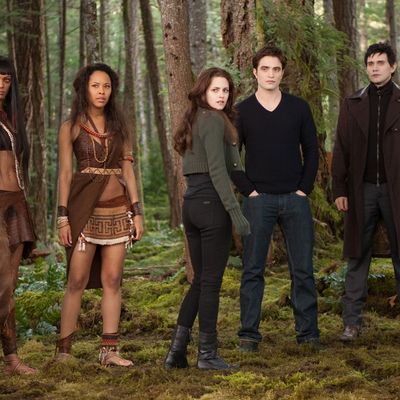
When last we left Twilight lead Bella Swan (in Breaking Dawn - Part 1), our frail heroine had just given birth to a half-human, half-vampire child and had been turned into a sparkling bloodsucker herself. Jacob “imprinted” on the small child, meaning that the central, uncomfortable love triangle was (even more uncomfortably) resolved, and everyone seemed poised to live happily ever after. Except: This is the Twilight world, meaning all sorts of weird vampire fights and mythology are yet to come. Breaking Dawn - Part 2 involves the aforementioned half-vampire baby, “immortal children,” some newborn vampire theory, surprise undead visitors from Brazil, and, of course, the return of the Volturi. Vulture understands how ridiculous that last sentence was, so we made you a cheat sheet. Here is how to keep all the vampires straight.
Vegetarian, “Good Vampires” (like the Cullens)
By vegetarian, the Cullens mean that they hunt animals rather than humans. (Edward’s favorite blood: mountain lion.) Like all vampires, they sparkle in the sunlight; they do not sleep or age; they are freakishly fast and agile and cold to the touch. Unlike other vampires, their feeding habits allow them to live in one place for an extended period of time and establish a community — making them rivals to the reigning vampire clan, the Volturis.
Classic, “Bad Vampires” (like the Volturi)
Cast your mind back to New Moon, when Edward ran away to Italy and tried to commit suicide by exposing himself in broad daylight (Vampire Rule No. 1: Don’t do that, or anything else that will blow up the collective vampire spot.) Those traditional vampire types, with the cloaks and the super-red eyes and the unfortunately long hair? They are the Volturi, who are essentially vampire royalty and who enforce vampire rules by torturing everyone with their special powers. (Dakota Fanning can just stare at someone and light their insides on fire, more or less.)
Newborn Vampires (like Bella)
“Newborn” here means freshly turned, since vampires cannot actually give birth. Still, imagine a brand-new human baby, who can only eat, sleep, or shit. Then give it the ability to run around crazy fast and hunt humans (its preferred food). Then take all the time the baby would have spent sleeping or getting its diaper changed and devote it to eating, since vampires do neither of those things. Now, make it look like an adult. Voilà, you have a newborn vampire: a giant, bloodsucking baby who does absolutely nothing but kill humans.
“Immortal Children” (a.k.a. Baby Vampires)
These are small children who have been turned into full vampires, meaning they will stay 5 years old (or 4 or 8, you pick) for the rest of their lives. Obviously, this means they are super-cute baby vampires, and as such, they can control people with a single look. Also, their tantrums kill people? (Look, we didn’t write this, we are just reporting the facts.) The Volturi are not too wild about these baby demons and outlawed their creation.
Half-Vampires (like Renesmee)
The tricky thing about half-vampires is that they age, but at an alarming rate — we’re talking puberty before 5. But they also live to at least 150 (at least according to our surprise Brazilian visitors). They shine rather than sparkle; they drink blood, but also have blood; unfortunately, they are so pretty that they look like “immortal children.” This is why the Volturi return, and why you are going to sit through a second Breaking Dawn movie. Good luck!




